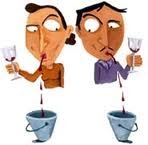Some of you might not know this, but about four years ago Paul was invited to market a few South African wines in Taiwan. And if you ever get the chance please ask him to tell you about his trip!
In the South African wine industry, the East, mainly China has been the topic of many conversations lately.
So naturally we will bring you up to speed on what all the talk is about. So here is what you should know:
Beginning in 1980, French and other Western wines began to rise in prominence in the Chinese market, both in mainland China and Taiwan. French-taught Chinese winemakers introduced wine to a market dominated mostly by beer, and have quickly expanded in scale such that China, with its immense population, is set to become the largest wine market in the world.
China is a country with an ancient wine tradition. The history of Chinese grape wine has been dated back more than 4,600 years. They also are a new and emerging wine-producing nation. Grape wine is a decidedly small portion of the total but this is slowly changing. Local wines account for 90 percent of wine consumed in China. China already produces more wine than Spain and Portugal combined and some of its brands are already stocked in supermarkets in the West, competing successfully against New World wines from countries such as Chile.
In 2008, it was predicted that within 50 years the quality of Chinese wine will rival that of Bordeaux. At the moment, a few large companies, such as Changyu Pioneer Wine, China Great Wall Wine Co., Ltd. and the Dynasty Wine Ltd., dominate the market.
Statistics show that the main market for white wine is among females, who prefer it over beer, still the main alcoholic beverage for most males; red wine has become a symbol of the elite and rich and is usually used as a table wine. In 2005, 80% of vineyards produce red wine and 20% of vineyards produce white wine, while 90% of wine consumed as of 2007 is red wine.
The move to marketing South African wine in China is one way of countering the 20% decline in sales of wine to the UK, says Neil Pendock, reports the Cape Times. “The future of South African wines is in the East” he says. Michael Fridjhon added that the weak Rand is causing export sales at a loss, and that British supermarkets “are absolutely calling the shots to South African wine producers…” A further threat to local wine producers is that supermarkets are increasingly stocking inexpensive imported wines, helped by the weak Rand.
South Africa is the world’s seventh-largest wine producer, and people drinking an average of about 7.5 liters a year, according to South African Wine Industry Information & Systems statistics. That compares with France’s average of 54 liters. South Africa exported about 390 million liters of wine in 2009, of which 4 million went to China. China's wine consumption at 0.4 liters per person a year is still quite low in international terms. In Australia also a country where wine is a big industry and also a part of many meals, consumption is 25 liters and even in the United States, where wine also is a major industry - 15 liters, according to AT Kearney figures. China is expected to move to seventh place by 2012 with a total consumption of 103.5 million nine-litre cases per year. This figure suggests a staggering increase of 36 per cent in wine consumption between 2009 and 2012, and will see China top the one-billion-bottle mark shortly.
South African bottled wine sales into China have increased by 50 %, albeit off a low base, and this market is estimated to be worth $6 billion by 2014, and about 34 million Chinese could be drinking wine by 2015, reports the Weekend Argus.
A number of leading South African wine brands will be exported into China. The exported wine brands include Alto, Jacobsdal, Neethlingshof, Plaisir de Merle, and Stellenzicht.
With wines like these we are sure to make a good impression!





